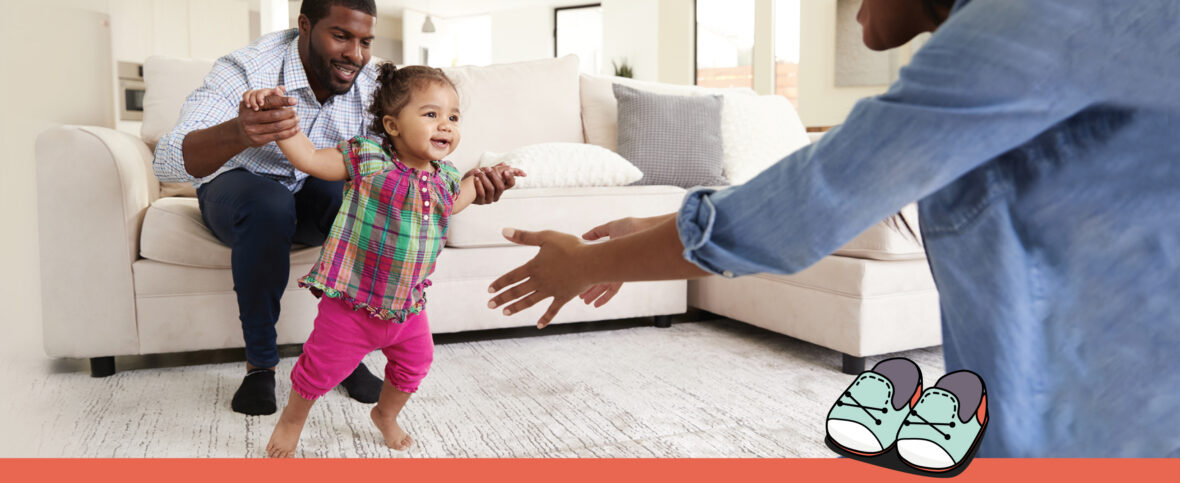See all > Parenthood

Flat feet & fallen arches in babies
Toddlers and young children usually have flat feet. So if you’re thinking to yourself, “my child is walking or running flat-footed,” you’re right! While flat feet or fallen arches might cause you some discomfort, they’re not typically cause for concern in little ones. In fact, it’s unusual for fallen arches in children to cause foot pain. But that doesn’t mean that your little one’s flat feet are always normal. Here’s everything you need to know about flat feet in babies and toddlers — from what’s normal, to when it’s time to see a pediatric orthotist.
What is pediatric flatfoot?
Flat feet in toddlers are so common that there’s a name for the condition: pediatric flatfoot (yes, it’s one word) or flexible flat feet. Because they’re growing so rapidly, children’s bones are more flexible than adult bones. This is great for some things — if they break a bone, they’ll heal more quickly than a grownup would, for example. It also means that when they stand up, the weight of their body is enough to flatten the arch right out of their cute little feet. This pretty much guarantees that your baby will walk with flat feet. Once they sit down, however, their foot should regain its arch. This usually stops happening by about age 10 when most children grow out of their flexible flat feet.
When to see a pediatric orthotist
One of the main concerns with flat feet is pain. In some adults, the symptoms of flat feet can be foot, hip, knee and even back pain. The good news is that most kids with flexible flat feet don’t have pain — but this isn’t always the case. If your child or preteen is complaining of foot pain or regular discomfort in their back, knees or hips, they should see a doctor. They might need orthotic inserts for their shoes or something else might be going on physically with them.
As long as they’re the flexible version, it’s unlikely you’ll need treatment for your child’s flat feet. But if your child’s foot doesn’t regain its arch when they’re sitting, they likely have a different condition. Total absence of an arch in the foot is called rigid flatfoot. Kids with rigid flatfoot need to see a doctor as the condition can sometimes be symptomatic of another condition like cerebral palsy or be caused by an injury. In these cases, your little one might need a pediatric orthotist referral to assess their need for orthotic inserts for their shoes or other treatment. But while it can be serious in some cases, rigid flatfoot doesn’t impact the majority of the people who have it.
How to treat flat feet
Unless you’ve seen a pediatric orthotist and they’ve told you otherwise, you don’t need orthopedic shoes for your flat-footed toddler. The best shoes for toddlers with flat feet are the same shoes any toddler would get — regular shoes with enough room for their feet and grippy soles. So unless your child has a really unusual gait, there’s nothing for you to do except wait. Their arch should develop somewhere between ages seven and 10.
While they need to see a doctor for any pain, if your child does experience tight heel cords (also known as the Achilles tendon) they can try some simple stretching exercises for treating flat foot discomfort. The main stretch involves pushing against a wall with both hands with one foot in front of the other. If they’re feeling it in the back of their calf, they’re doing it right. If not, they can try moving their back foot further back from the wall. Just make sure they have a good grip with their feet to avoid sliding out and down face first.
Most children outgrow their flat feet by age 10 as their bones begin to harden. If your 11-year-old is still walking around with flat feet though, don’t despair. Some people retain their flat feet throughout their lives without issue. The condition of flat foot is often hereditary so chances are good that you or your partner has the same issue. When it comes to your kid, any abnormalities are always concerning for parents. But with flat feet, if they’re not in pain, there’s probably nothing to worry about.
The information presented here is for educational purposes and is not meant to replace the advice from your medical professional.
When using virtual care, all medical treatment is at the sole discretion of the provider. Virtual care is not meant for medical emergencies, and your provider will determine if your case is appropriate for virtual care. If you are experiencing an emergency like chest pain or difficulties breathing, for example, please call 911 or go to your nearest emergency room.
Trusted by millions of Canadians
Get started now

We're trusted by millions of Canadians
Join millions of Canadian families who enjoy 24/7 access to medical care within minutes.
Get started now4.6 score
5K+ Trustpilot reviews
Do you need medical care today?
Trusted, experienced doctors and nurse practitioners are ready to see you.
